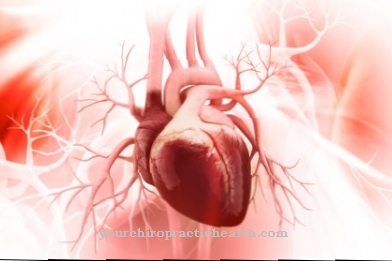Ergot alkaloids are naturally occurring, active ingredients that are mainly found in ergot fungus (Claviceps purpurea). They are used as an isolated component in various drugs due to their psychotropic, labor and blood circulation-promoting properties.
What are ergot alkaloids?
The parasitic crescent-shaped cereal fungus mainly grows in ears of cereal after the grain has been infected. Since alkaloids, as secondary plant substances, have a high toxicity, various strategies are used to prevent infestation in agriculture. Until the 20th century there was regular mass poisoning through the consumption of contaminated grain, which was called "ergotism". Today the term is used for the side effects that occur with chronic use of ergotamine.
In its structure, ergot alkaloids consist of ergoline, a nitrogen-containing, organic-chemical compound, the abstracted substances of which are used in the treatment of migraines, hypotension, Parkinson's disease and cardiovascular diseases. Lysergic acid is obtained from the ergot fungus, which is used to produce LSD (lysergic acid diethylamide). For this reason, the supply of the drug ergotamine is restricted by the German Basic Substance Monitoring Act.
Even in low concentrations, the alkaloids of ergot have a toxic effect and affect the central nervous system. The alkaloids and derivatives of the grain parasite are currently being discussed as neuro-psychotropic drugs. In pharmacological parlance, “dirty drugs” are drugs that bind to various receptors in the brain. On the one hand, this leads to a wide range of effects, but is often associated with unpredictable side effects. Science is working to approach a more targeted effect.
In addition to ergot alkaloids, the British biochemist Henry Hallett Dale was able to detect histamine as a natural substance in ergot.
Pharmacological effect
Ergot alkaloids work in the body in a variety of ways. They are primarily referred to as dopamine agonists. This means that they stimulate the dopamine receptors and thereby intensify the dopamine effect in the body. They intervene directly in the vegetative nervous system, which coordinates our body and organ functions. This effect is used, for example, in Parkinson's disease, as the disease is mainly triggered by a lack of dopamine.
Individual ergot alkaloids can cause neurological disorders and affect the central nervous system even at low concentrations. This can lead to epileptic fits or cramps. Other alkaloids contain a toxic agent that can cause limbs to die by blocking blood vessels.
Five to ten percent of ergot can cause death in an adult. This is due to the composition of the various ergot alkaloids and their high concentration.
The active ingredients can both block and stimulate the receptors on the blood vessels. Depending on which alkaloid it is. The successful treatment of migraines is explained by the effect on the blood vessels. The binding of the substances to the alpha receptors in the muscles also causes the uterus to contract.
One ergot alkaloid used is ergometrine. It is a uterotonic (has a tonic effect on the uterus), which has an alpha-sympatholytic effect (counteracts the effects of the sympathetic nervous system) and has a direct stimulating effect on the smooth vascular muscles and the uterus. In the venous system, ergotamine in its natural form has a pronounced vasoconstrictor (constricting) effect on venous and arterial vessels.
In addition, a serotoninergic (serotonin-reactive or serotonin-containing) effect is discussed. Ergotamine derivatives can be found in breast milk. They can induce vomiting, diarrhea and hypertension in the breastfed infant.
Lysergic acid dilates the pupils and increases blood pressure, can trigger changes in perception in terms of time as well as optical and acoustic stimuli. LSD is a mood-altering hallucinogen.
In addition, some derivatives of ergot alkaloids are used. Bromocriptine and cabergoline, for example, have dopaminergic properties and inhibit the release of the hormone prolactin. Dihydroergotamine regulates blood pressure and blood vessels. Dihydroergocryptine acts selectively on D2 receptors.
Dihydroergotoxin, in turn, in combination with other preparations can have a positive effect on brain performance and is antihypertensive. Lisuride and pergolide bind to dopamine and serotonin receptors. Methylergometrine has a contracting (tonic) effect on the uterus.
Medical application & use
In medicine, the substances in the fungus, despite their toxicity, represent a group of analeptics with a high degree of effectiveness. They are therefore used for a wide variety of diseases.
Dihydroergotamine for: hypotension, fainting spells, cardiovascular problems, acute migraine attacks with and without aura.
Dihydroergotoxin in: hypertension / old age hypertension, accompanying treatment of Raynaud's syndrome, visual field disorders of vascular origin, symptomatic treatment of veno-lymphatic insufficiency, brain disorders, Alzheimer's disease, dementia, migraine. Even small amounts can cause nausea and vomiting. The remedy is therefore also used as an emetic.
Ergotamine for: cluster headaches, migraines. Dihydroergocryptine, lisuride, cabergoline and pergolide in: Parkinson's disease. Dihydroergocryptine in: Parkinson's disease and interval treatment of migraines. Bromocriptine for: Restless Legs Syndrome, Menstrual Cycle Disorders, Infertility in Women, Hyperprolactinanemia in Men, Prolactinomas, Acromegaly, Benign Mammary Diseases and Parkinson's Disease.
Cabergoline in turn for: Hyperprolactinemic disorders. Methylergometrine for: promotes placental detachment, treatments of uterine atony and the treatment of postpartum bleeding.
Risks & side effects
The following side effects can occur: headache, vomiting, with long-term treatment circulatory disorders in the hands and feet up to vascular obstruction and death of the affected region, angina pectoris, gastrointestinal complaints, loss of appetite, sleep disorders, restlessness, nasal congestion, constipation, slow heartbeat, drop in blood pressure , Circulatory problems, dizziness, itching, tingling as well as numbness and coldness in arms and legs, feelings of anxiety, depression, skin reactions, muscle weakness, muscle pain, muscle cramps, heart rate that is too slow or too fast (bradycardia, tachycardia), heart valve damage, heart attack, heart stumbling, breathing disorders, edema , Fibrosis, dyskinesia, hallucinations, hypotension, drowsiness, sweating, dry mouth, stomach pain, stomach cramps, feeling of weakness, heartburn, water retention in the tissue, weight change, restlessness, loss of libido, tremors, ringing in the ears, nightmares, delusions, upper abdominal discomfort weakness of expression, painful legs, hair loss, visual disturbances, psychosis, nervousness, incoordination, incontinence, frequent urination, paleness of the face, stroke, uterine contraction pain, hypogalactia and behavioral disorders.
Common side effects of all dopamine agonists are increased libido and hypersexuality, binge eating, obsessive-compulsive disorder and reduced impulse control.



























